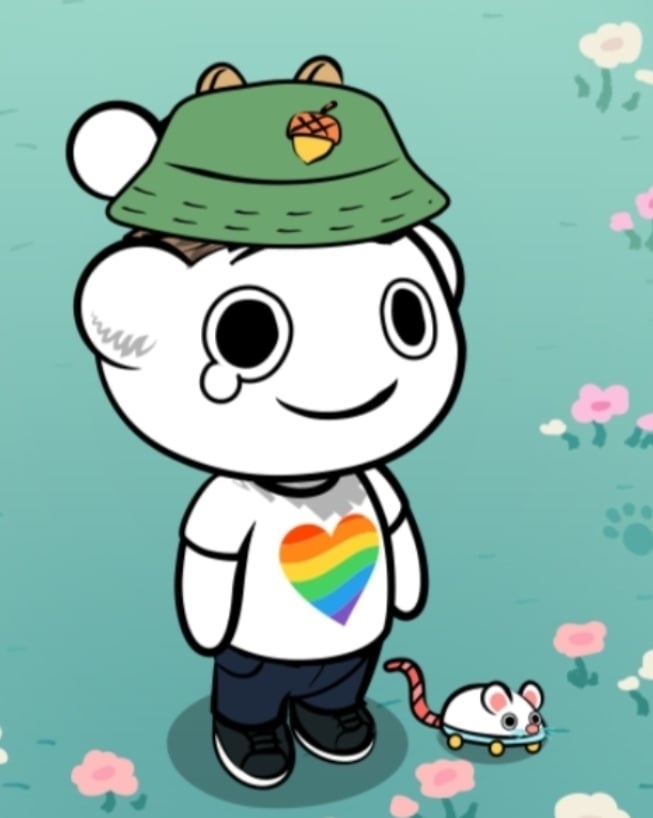Yeah, fair enough.
It’s the one position he holds that isn’t completely crazy (and that shot of him being forced to pose with a Big Mac was pure comedy). He’ll kill millions with his vaccine views, but I can get behind this.
Of course if a Dem announced this, conservatives would be drinking paint in solidarity with dye manufacturers.

And a dumpster fire provides warmth.
I’m in Canada where we have restricted some food dyes. I miss the old colours of Froot Loops and Smarties (similar to M&Ms, not rockets). But it’s fine because those colourants really do only exist to make junk food look good.
It’s not clear to me the exact scope of what they consider to be artifical dyes though. Is a dye produced by a genetically modified bacteria natural enough?
Conservatives have been saying that Dems want to force them to eat bugs, so it’s a little strange to be tacitly encouraging the use of Natural Red 4 which is made from crushed beetles.
The fun thing about “natural” vs “artificial” dyes is pretty nothingburger in reality. The manufacturers of chemical dyes, scents, etc. just generate the chemical by whatever means. If it’s a “natural” flavor/scent/color it is derived from something like a beetle or a flower. If it’s “artificial” it is derived via a chemical process. The end product is the same.
Reminds me of some years back when Starbucks answered the cry of, “but we don’t want artificial flavors/colors in our coffee!” so they started using a red dye for one of their drinks that was derived from crushed up beetle shells. People then freaked out, “I don’t want to drink beetle shells!!!”
TL;DR: The end product is the same, whether it be natural or artificial. The real concern, is if the product should really be consumed at all.
The Big Brains like RFK Jr. likely lack the mental capacity to understand such concepts, so all the dyes will become “natural” and stick around, and just increase the number of purée’d parakeets. Basically, another shitty cup game.
TL;DR: The end product is the same, whether it be natural or artificial. The real concern, is if the product should really be consumed at all.
This is hot crap. They are different chemicals, the end product is not the same and you’re spouting misinformation.
Most of the artificial dyes that people have banned in countries other than the USA are derived from petrochemicals. Natural dyes have been in use far longer and have been shown to have fewer negative health outcomes.
Eg. Red dye containing bugs (cochineal, E120) has no known health effects except to an extremely small percentage of the population whom are allergic to bugs, hence it is marked as an ingredient when used, to alert those with allergies. Its replacement alternatives are:
- red dye #2 (amaranth, E123) which was made from coal tar, and is now made from petroleum byproducts. It is a suspected carcinogen and is banned in most of the world including the US.
- red dye #3 (erythrosine, E127) was first extracted from coal tar and is derived from phenol, currently extracted from petroleum byproducts and it is a known carcinogen and restricted heavily in what it can be used in since the early 1990s in every developed nation except the USA, until this very announcement by the FDA and RFK jr which will bring the USA in line with the rest of the world’s protections. California also separately banned it in October 2023.
- red dye 40 (Allura red) is an entirely synthetic dye invented by a chemical corporation in 1971 by azo coupling between diazotized 5-amino-4-methoxy-2-toluenesulfonic acid and 6-hydroxy-2-naphthalene sulfonic acid. I don’t know what that means in order to determine if its feedstocks are petrochemicals, but mice studies showed bowel disorders and DNA damage which caused several countries to ban it over the years, however it’s currently believed to be safe if the maximum daily limit is adhered to.
And that’s just red dye.
You’re talking about different chemicals as a comparison not a 1:1. I’ll concede that some dyes may indeed exist only from chemical derivation. However, many do not. We’ve already put more thought into this than RFJ Jr. has, btw. (Not all dyes referenced below are foodsafe, to be clear, just a quick comparison chart.)
Random table of dyes that can be derived both ways:
Dye Name Natural Source Synthetic Production Chemical Formula References Indigo Indigofera tinctoria (plant) From aniline via Baeyer-Drewsen synthesis C₁₆H₁₀N₂O₂ PubChem, Shepherd Textiles Alizarin Rubia tinctorum (madder root) From anthraquinone C₁₄H₈O₄ Wikipedia, PubChem Tyrian Purple Murex sea snails Bromination of indigo C₁₆H₈Br₂N₂O₂ Wikipedia, PMC Article Cochineal (Carminic Acid) Dactylopius coccus (insect) Complex synthesis; often insect-derived C₂₂H₂₀O₁₃ PubChem, Wikipedia Curcumin Curcuma longa (turmeric root) Lab synthesis possible C₂₁H₂₀O₆ PubChem, Wikipedia Lawsone Lawsonia inermis (henna leaves) From 1,4-naphthoquinone C₁₀H₆O₃ Wikipedia, ACS Betanin Beta vulgaris (beetroot) Rarely synthesized due to complexity C₂₄H₂₆N₂O₁₃ Wikipedia, PubChem Quercetin Various plants (e.g., onions, apples) Can be synthesized; mostly extracted C₁₅H₁₀O₇ Wikipedia, PubChem
When the pigeon knocks over the chess pieces, it sometimes accidently makes a good move.
Canada and the EU did that year’s ago.
Good luck selling the salmon at this point if you do that
https://thekitchenknowhow.com/is-salmon-dyed/
Farm-raised salmon would be fine.
Or ‘black’ olives.
Black olives are not dyed black.
Well, ripe olives are naturally black, yes. But many, if not most “black” olives you find on the supermarket shelves are dyed. Look out for “Iron(II) gluconate” on the ingredient list.
Jesus Christ, talk about brain worm logic.
Not everything with a name you think looks funny is some synthetic, bad for you ingredient on par with petroleum-based dye.
FFS, https://en.m.wikipedia.org/wiki/Iron(II)_gluconate
It’s literally an iron supplement that people take for iron deficiency and made by just dissolving iron in acid and gathering the participate and it’s completely freaking safe.
God damn, learn to science.
Shit, are you going to complain about acetylsalicylic acid too?
The point I was making is that (most) black olives are indeed dyed black. Nothing more, nothing less.
That does not describe a process using black dye. That describes oxidation during the curing process.
Does oxidation result in discoloration? If so, they’re dyed! (/s)
Did this worm farm just do something decent?
I’m going to assume that worm brain will move to ban more than the programmatic petroleum-based additives and ban anything that has a synthetic sounding name.
It says “remove them”, not “forbid them”. The Nation’s food supply is going to be dunked in ammonia before you can eat it.
Adding a “/s” because given the times this sounds weirdly plausible…
This is very much a stopped clock situation.
Also, how are they gonna regulate and enforce this, considering the FDA is gonna stop administering food safety?
Despite jr being a massive fuckwit, this is actually good
The EU accepts his concession.
I mean. This was already on its way. I thought Trump would force it to be reversed.
You can’t eat dyes in food when you have died from a pandemic
So they found an expert in the field whose last name is Nestle. It’s not confusing at all.
Marion Nestle isn’t just AN expert. She is THE expert in food science. You would be hard done by to find a more qualified and well spoken fount of knowledge.
- Brandeis University, lecturer in biology, 1971-73
- Brandeis University, assistant professor of biology, 1974-76
- UCSF School of Medicine, lecturer in biochemistry and biophysics, 1976-84
- UCSF School of Medicine, associate dean, school of medicine, human biology programs administrative director, medical scientist training program, 1976-86
- UCSF School of Medicine, lecturer in medicine, 1979-84
- UCSF School of Medicine, acting director, medical scientist training program 1983-84
- UCSF School of Medicine, lecturer in family and community medicine, 1984-85
- UCSF School of Medicine, director, John Tung/American Cancer Society clinical nutrition education center, 1984-86
- UCSF School of Medicine, adjunct associate professor, family and community medicine, 1985-86
- UCSF School of Medicine, associated faculty, Institute for Health Policy Studies and Institute for Aging Health Policy, 1983-86
- Office of Disease Prevention and Health Promotion, Department of Health and Human Services, Washington, DC, staff director for nutrition policy, senior nutrition policy advisor, managing editor, Surgeon General’s Report on Nutrition and Health (1988), 1986-88
- New York University, School of Education, professor and chair, nutrition and food studies, 1998-2003
- New York University, professor and director of Public Health Initiatives, 2003-04
- New York University, Paulette Goddard Professor of Nutrition, Food Studies, and Public Health, c. 2004—
- New York University, honorary professor in the Department of Sociology, 2006
She literally wrote the book on how nutrition is politicized and obfusticated by capital.
TIL, thank you. I’ll be looking out for future statements of her.
nominative determinism
One of my favorite phrases
That’s honestly the least unhinged policy he’s likely to push.






